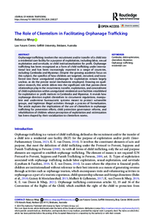Orphanage trafficking involves the recruitment and/or transfer of a child into a residential care facility for a purpose of exploitation, including labor, sexual exploitation and servitude, or child institutionalization for profit. Orphanage trafficking has been recognized as a form of child trafficking under international law and has been increasingly reported in a range of countries, including Cambodia and Myanmar. Despite the growing academic focus on this subject, the specifics of how children are targeted, recruited, and transferred into these unregulated orphanages for exploitation remain largely unclear, as do the precise social mechanisms employed.
Drawing on qualitative research, this article delves into the significant role that patron-client relationships play in the recruitment, transfer, exploitation, and concealment of child exploitation within unregulated residential care facilities established for exploitative or profit motives in Cambodia and Myanmar. It reveals how orphanage directors exploit clientelism to circumvent regulations, manipulate and undermine bureaucratic systems meant to protect vulnerable groups, and legitimize illegal activities through a process of formalization.
The article explores the implications of the use of clientelism in orphanage trafficking for prevention efforts, child protection governance reforms, and rehabilitation of children whose perception of exploitation and victimization has been shaped by their socialization to clientelism norms.

